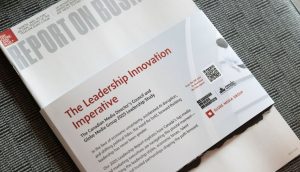If the organizers of last night’s CrossmediaTO event in Toronto designed the pace of the evening to match the pace of change in the mediascape today, they certainly achieved their goal.
With 12 speakers packed into a two-and-half-hour format, the night’s schedule was fast and furious, a strategy designed to shake up the traditional conference format, as Gavin McGarry, CrossmediaTO host and president of Jumpwire Media, made sure to note during a pause between speakers.
With a goal to get different people from the mediascape talking to, and learning from, one another, the evening kicked off with a demonstration from Pickering, ON-based ES3, who showed off their proprietary IPTV platform and applications.
MiC was immediately pleased, after recently wondering ‘will they monetize the interactive capabilities of IPTV?’ that yes, ‘they’ can and ‘they’ are. ES3 is a global partner for the Microsoft Mediaroom IPTV platform, designing applications for IPTV service (which is provided by Bell and Telus in Canada). Although the demonstration of ES3’s TV Dashboard product (much like the Dashboard on a Mac computer) included super-cool features such as ‘sticky notes’ you can leave for others on your TV screen, marketer-friendly features included fully interactive environments, such as the Tumblebooks TV educational app. The dashboard also appeared to feature ad units too, as you can see by the small Nike ad in the photo below.

After a development-process iPad app demonstration by Shark Teeth Films speaker Adrian Carter, Bitstrips.com CEO Jacob Blackstock enthralled the crowd with his demonstration of the website. Bitstrips.com allows people to create quick and easy comic strips by using the tools on the site. The goal behind the site is to ‘reinvent comics as a means of communication for everyone’ Blackstock said, and make the comic strip as user-friendly a communication tool as email.
Seemingly a bit frivolous at first, Bitstrips.com has momentum behind it, with an average of 10 million page views per month, average user-stickiness of 14 minutes on the site, and an average of 20,000 comics being created every day. The angle for marketers? Bitstrips does allow product integrations, which site users can (and love to) insert into their strips: ‘If we brought in a [Burger King] Whopper, you would see 10,000 comics involving Whoppers in a week,’ he said.
One of the key themes of CrossmediaTO was the idea of ‘melting silos’ and discussing the idea of how media professionals can better work together. Speakers Colleen DeCourcy, former CDO, TBWA Worldwide, and Richard Bernstein, SVP managing director, Arc Worldwide, both discussed the increasing need to reach outside of traditional agency structure in today’s media and advertising landscape. Their back-and-forth debate about the changing structure of agencies included banter about the changing skill sets required by advertising professionals, and how agencies are turning more to outsourced talent to meet the demands of the digital mediaverse. Addressing the conference audience, Bernstein noted that those in content development should perhaps take a harder look at ways of working with agencies, as ‘we’re getting the budget that can pay for those kinds of things,’ he joked.

Transmedia expert Siobhan O’Flynn was the second-last speaker of the evening, outlining some key ‘disruptive innovations’ in media over the last few months, highlighting director Ridley Scott’s ambitious Purefold project and recent announcement of the crowd-sourced Life in a Day documentary project, as well as the popular Phillips-sponsored Parallel Lines film project.
Content, she said, ‘is a gift.’ Elaborating, she said the way that people engage with media today means that if a project has content that people value, those people will become loyal, especially if you let them contribute. And what might have had a regional or national audience before can easily have global audience today, with the right open concept.
The evening wrapped with an engaging presentation from CBC Radio 3 director Steve Pratt, who explained the model behind Radio 3’s DIY format, explaining that the Ceeb looks at the online radio station as an ‘innovation centre’ for the broadcaster, and attributing its success to looking at themselves as a music delivery service, rather than a fixed traditional radio format.
‘We are defined by our content, but not by our platform,’ he noted.























